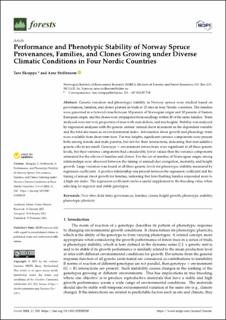| dc.description.abstract | Genetic variation and phenotypic stability in Norway spruce were studied based on provenances, families, and clones planted in trials at 12 sites in four Nordic countries. The families were generated in a factorial cross between 10 parents of Norwegian origin and 10 parents of Eastern European origin, and the clones were propagated from seedlings within 20 of the same families. Traits analyzed were survival, proportion of trees with stem defects, and tree heights. Stability was analyzed by regression analyses with the genetic entries’ annual shoot increment as the dependent variable and the total site mean as an environmental index. Information about growth and phenology traits were available from short-term tests. For tree heights, significant variance components were present both among female and male parents, but not for their interactions, indicating that non-additive genetic effects are small. Genotype × environment interactions were significant at all three genetic levels, but their variance components had considerably lower values than the variance components estimated for the effects of families and clones. For the set of families of Norwegian origin, strong relationships were observed between the timing of annual shot elongation, mortality, and height growth. Large variation was found at all three genetic levels for phenotypic stability measured by regression coefficients. A positive relationship was present between the regression coefficient and the timing of annual shoot growth for families, indicating that later flushing families responded more to a high site index. The regression coefficient can be a useful supplement to the breeding value when selecting for superior and stable genotypes. | en_US |

